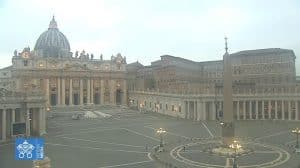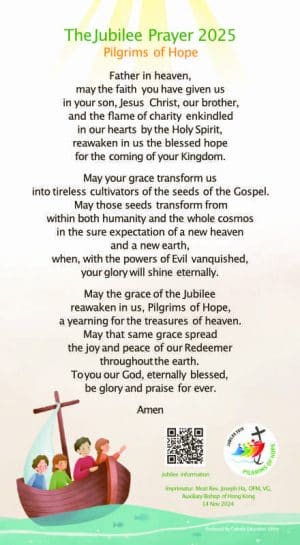The experience of the Risen One told in this Gospel passage took place in Jerusalem on Easter Sunday. The day began with the journey of the women to the tomb and with the announcement of the resurrection (Luke 24:1-8).
At night, the eleven and a group of other disciples who were with them were talking of the manifestation of the Risen One that Simon and a few others had. Then the two disciples of Emmaus, almost out of breath, came and reported what had happened to them along the way and how they had recognised the Lord in the breaking of bread.
In this context, we can imagine the irrepressible joy when Jesus himself appeared among them (vv. 35-36).
We would expect the reaction John referred to us: “The disciples kept looking at the Lord and were full of joy” (John 20:20). Luke says instead that they were “amazed, frightened and upset,” believing of “seeing a ghost” and “doubts in their hearts” rose (vv. 36-38). Their reaction was inexplicable. How to reconcile joy with doubts?
To them, as to us, the reality of the resurrection has appeared, at times, too good to be true. In some circumstances, they had the feeling of having to deal with ghosts.
Luke’s emphasis on the corporeality of the Risen One comes from a pastoral concern: the Christians he addressed to were imbued with the Greek philosophical ideas. They did not deny that, after death, he went into a new form of life, but this was reduced to survival of the spiritual component of man. The bodily resurrection was inconceivable and, when apparitions of the dead were reported, they always imagined shadows, spirits or ghosts.
At this point we try to reformulate the passage’s theological message using a language more understandable to our culture.
The Risen One—ensures Luke—was not a ghost, but the same Jesus that the disciples had touched with their hands and with whom they had eaten. He had changed his appearance; a sublime metamorphosis that made him unrecognisable had taken place in him. He was transfigured, but it was not another person. He kept his body, his ability to manifest himself outwardly, to relate, to communicate his love, but his was a body different from ours, it was—as taught by Paul—a “spiritual” body (1 Corinthians 15:44).
He has a body that allows him to continue to eat and drink with us, that is, to share our hopes and delusions, our joys and sorrows. He is not out of reach, not a spirit irremediably distant and detached from our reality. Even after his return to the Father, he remains fully human, one of us.
He is not the only risen one; he is the first raised from the dead (Colossians 1:18). What happened to him is repeated in every disciple. At the time of death, there won’t be a split of the soul from the body (this is Greek philosophy, not a biblical concept), but the human, as a whole, will be transfigured in God’s world.
Now the invitation of the Risen Lord to look at his hands and his feet is better understood (v.39). While people are identified by the face, Jesus wants to be recognised by the hands and feet. The reference is to the wounds impressed by the nails and to the cross, culmination of a life spent for love.
The body of Jesus conserves the signs of his total self-giving as the Resurrected One.
Faith is always given within a community. Jesus is not recognized in solitude but in the relationship with the brothers and sisters who form the ecclesial community. It is the believing community that makes the journey of faith, supporting each other, putting together doubts and difficulties, discoveries and defenses. Sharing a common faith has its share of complexities, but it’s more joyful than believing in solitude. In the fraternal relationship, the confession of faith becomes a public commitment that I must verify in my daily conduct before others.
This reality, so fundamental for the Church, is reflected in this Sunday’s readings. The Acts of the Apostles emphasises the aspect of the sharing of everything by the community of believers. Those who made up the Church of those early days had everything in common. In the midst of the community the apostles witnessed to the resurrection of the Lord. The witness was welcomed and shared. Faith as well as the lives of the faithful were shared and celebrated in all their dimensions. So that no one was in need.
But that did not mean that the early community did not have problems, that believing was easy for them. On the contrary, it was not easy even for the apostles themselves. Faith in the resurrection of Jesus was not something achieved in the blink of an eye. It was a process in which the apostles and the other disciples grew together. Today’s Gospel is a direct witness to this reality.
Jesus who was crucified, now presents in the midst of his disciples, speaks to their hearts, and confirms them in their faith. There is also the curious case of Thomas who was away from the community at the time of Jesus’ appearance to the disciples. He insists to see the Risen Lord and he wants to see the signs of the nail-wounds and touch him. He wants to be sure that he is not deceived by some hallucinations of his fellow companions. The Lord who is not physically present with Thomas at the time he insisted seeing him, but apparently knew exactly what he was asking for. In his appearance a week later, Jesus answers all the demands of Thomas. He saw it and believed.
Today it is proposed to us to meet Jesus. Not with the Jesus we imagine but with the real Jesus of the Gospels. We are obliged to read them in detail. To commit ourselves to follow him, because he is alive, he is around! To believe in his resurrection means nothing can remain the same. In front of our brothers and sisters we commit ourselves to live as people who live as Jesus lived.
For your reflection
To say that Jesus has risen means to believe in eternal life, but does it also have any consequences for this life? How can I be a sign of resurrection for those who live with me, for my family or my community? Do I dare to commit myself to being a Christian in front of my community?
Father Fernando Armelllini CMF
www.ciudadredonda.org
Translated by
Father John Ladesma SD
Abridged by
Father Jijo Kandamkulathy CMF










